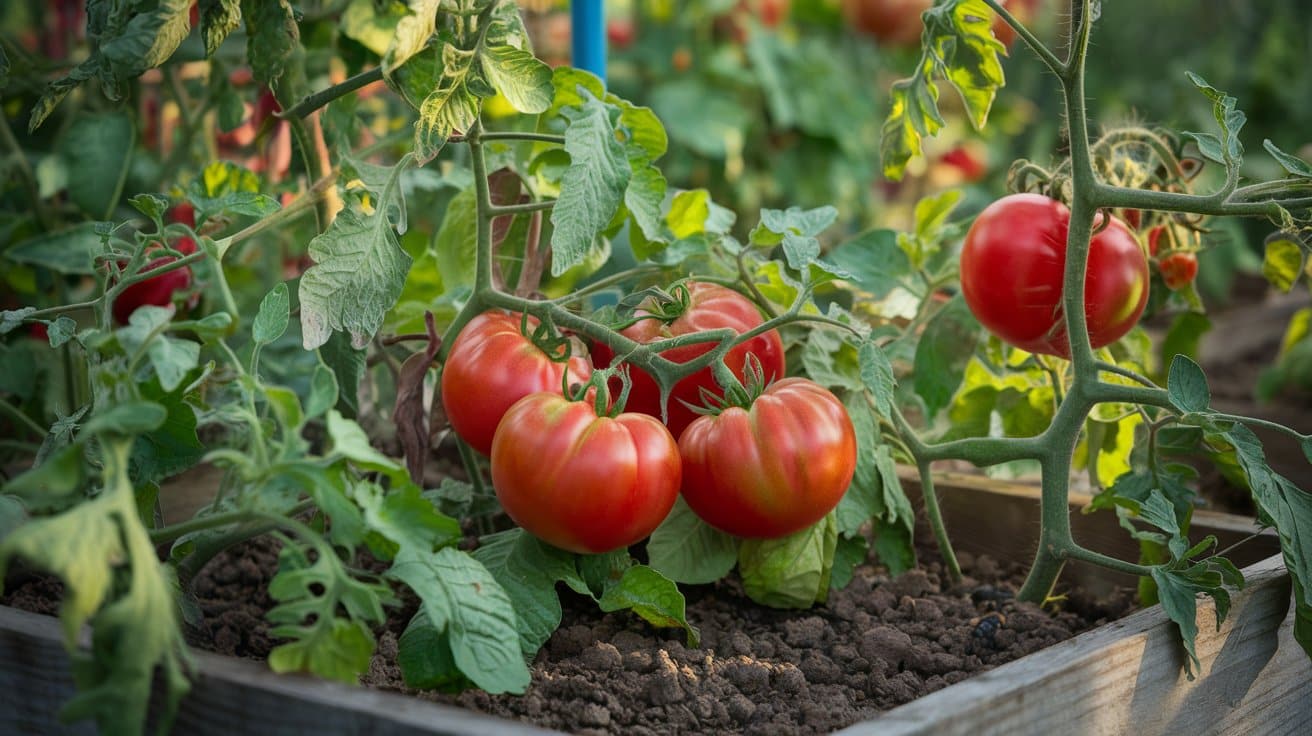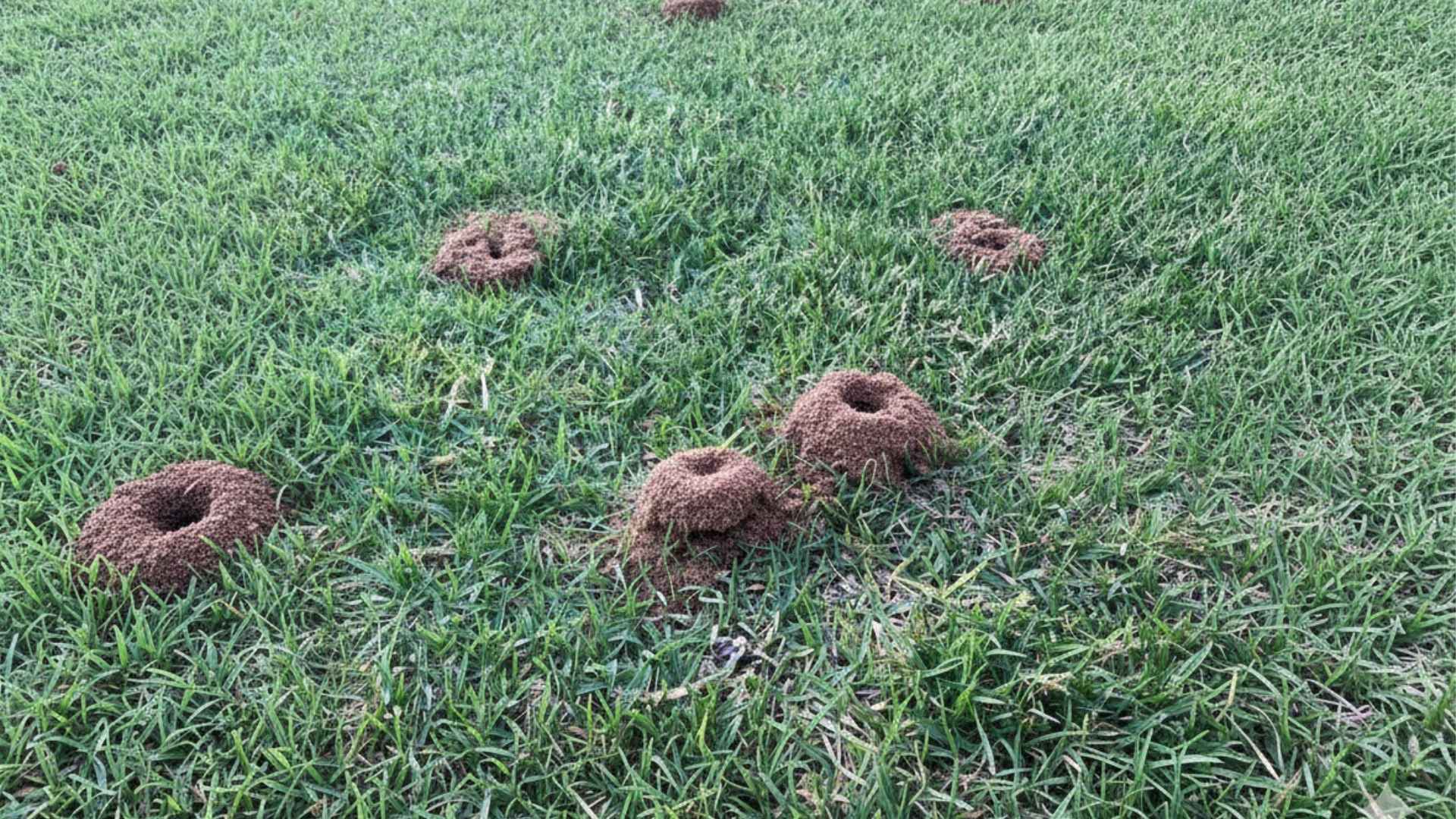Ever wondered why your neighbor’s tomato plants look so healthy while yours struggle to produce fruit?
Growing tomatoes successfully isn’t just about planting seeds and hoping for the best. It requires understanding what these plants truly need to flourish.
This guide will walk you through every step of tomato growing. From selecting the perfect variety to harvesting ripe, juicy tomatoes from your own garden.
You’ll learn about soil preparation, proper planting techniques, ongoing care, and how to protect your plants from common problems.
Whether you’re a complete beginner or looking to improve your tomato growing skills, this comprehensive guide covers everything you need to know.
Get ready to grow the best tomatoes you’ve ever tasted.
What Do Tomato Plants Need to Thrive?
Tomatoes are warm-season plants that require specific conditions to produce healthy fruit. Understanding these basic needs forms the foundation of successful tomato growing.
1. Sunlight Requirements
Tomato plants need at least 6-8 hours of direct sunlight daily. Without enough sun, plants become weak and leggy. They produce fewer flowers and smaller fruit.
Place your tomato plants in the sunniest spot in your garden. South-facing locations work best in most climates. Avoid areas shaded by trees, buildings, or fences.
2. Temperature Preferences
Tomatoes grow best when daytime temperatures stay between 70-80°F. Night temperatures should remain above 55°F. Cold temperatures below 50°F can damage or kill young plants.
Wait until soil temperature reaches 60°F before planting. Use a soil thermometer to check. Cold soil slows root development and stunts growth.
3. Soil Requirements
Good soil drainage is essential for healthy tomato plants. Waterlogged soil causes root rot and plant death. Sandy loam or well-draining garden soil works perfectly.
Soil pH should range between 6.0-6.8 for optimal nutrient uptake. Test your soil with a simple pH kit. Add lime to raise pH or sulfur to lower it if needed.
4. Water Needs
Tomato plants need consistent moisture but not waterlogged conditions. Aim for 1-2 inches of water per week. Deep, infrequent watering works better than daily light sprinkles.
Water the soil level to keep leaves dry. Wet leaves encourage fungal diseases. Morning watering allows plants to dry before evening.
5. Space and Air Circulation
Plant tomatoes 24-36 inches apart for proper air flow. Good circulation prevents fungal diseases and keeps plants healthy. Crowded plants compete for nutrients and sunlight.
Avoid planting tomatoes in low-lying areas where cold air settles. These spots stay wet longer and increase disease risk.
How to Prepare the Right Environment for Tomatoes?
Successful tomato growing begins weeks before you plant your first seed. Environmental preparation determines whether your plants will thrive or struggle throughout the season.
Many gardeners rush into planting without proper groundwork. This leads to poor harvests, diseased plants, and wasted time that could have been avoided.
Before starting your environment preparation, you’ll need these basic tools
- Garden spade or shovel for digging soil 8-12 inches deep.
- Use a hand rake for removing weeds and mixing compost.
- A measuring tape for proper spacing and depth measurements.
- A wheelbarrow for moving compost and organic materials.
- Stakes or posts for plant support installation.
- Hammer or mallet for driving stakes 2 feet deep.
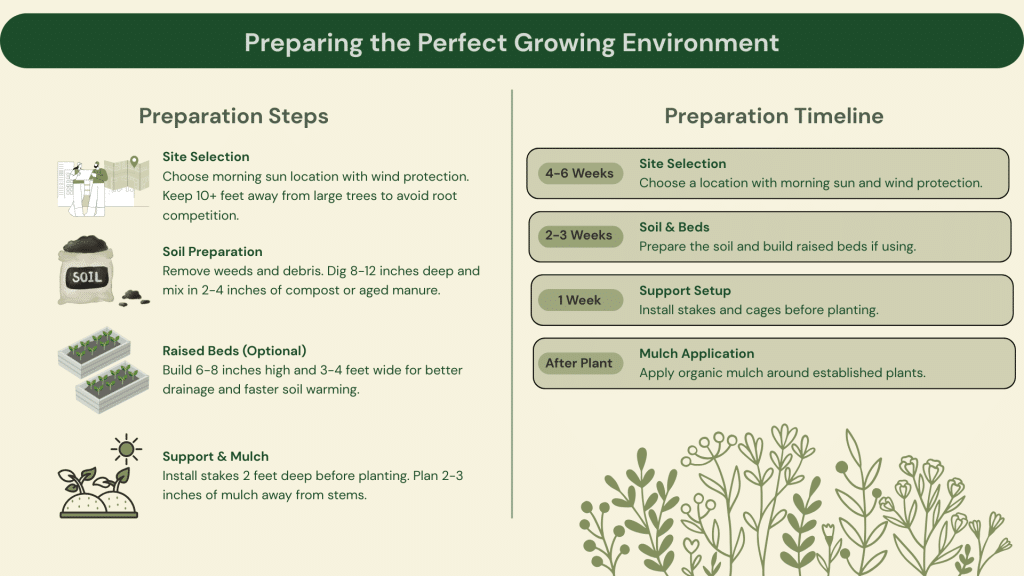
Check soil acidity levels with a garden pH tester. Aim for a slightly acidic range where tomatoes thrive, around pH 6.0 to 6.8, adjusting with amendments as required.
Consider your local climate zone when planning preparation timing. Cold regions need later start dates, while warmer areas can begin preparation much earlier.
Choosing the Right Tomato Variety
Different tomato varieties have unique growing requirements and harvest characteristics. Your choice affects plant size, fruit type, and maintenance needs throughout the season.
Consider your garden space, climate conditions, and intended use before selecting varieties. Some types work better for fresh eating, while others excel in cooking.
Tomato varieties fall into two main categories. Determinate types grow to 3-4 feet and produce fruit all at once over 4-6 weeks.
Indeterminate varieties reach 6-8 feet with continuous production until frost. Tomato plant care becomes more intensive with larger varieties, but it offers better yields.
| Variety Type | Height | Harvest Pattern | Best For | Popular Examples |
|---|---|---|---|---|
| Determinate | 3-4 feet | All at once (4-6 weeks) | Small gardens, containers | Roma, Celebrity, Bush varieties |
| Indeterminate | 6-8+ feet | Continuous until frost | Large gardens, long harvest | Beefsteak, Big Boy, Cherokee Purple |
| Cherry | 4-6 feet | Continuous, abundant | Snacking, salads | Sweet 100, Sun Gold, Black Cherry |
| Slicing | 4-6 feet | Weekly harvest | Fresh eating, sandwiches | Beefsteak, Big Boy, Brandywine |
| Paste | 3-5 feet | Heavy production | Sauces, canning | Roma, San Marzano, Amish Paste |
Match variety selection to your cooking habits and storage needs. Fresh market types differ significantly from processing varieties in texture and shelf life.
Start with 2-3 different varieties in your first season. This approach helps you learn how to look after tomato plants while comparing performance and taste preferences.
How to Start: Seeds vs Seedlings and Planting Steps
Growing from seeds unlocks a broader selection at a lower cost, but demands early indoor care. In contrast, seedlings are quicker to plant outdoors, yet limit variety choices.
Seeds offer access to hundreds of varieties not available as transplants and cost significantly less per plant. They require indoor starting 6-8 weeks before the last frost, but provide complete control over growing conditions.
Seedlings from nurseries save 6-8 weeks of indoor growing time and eliminate germination concerns. They cost more than seeds but offer instant results with established root systems ready for transplanting.
You have two options to get tomato plants in your garden. Choose based on your time, budget, and variety preferences.
|
If you’re looking for more variety and lower costs? Choose seeds. You’ll start them indoors 6-8 weeks before planting season, grow them under lights, then move them to the garden. If you’re looking for convenience and quick results? Buy seedlings from a nursery. You skip indoor growing and plant directly in the garden when the weather warms up. |
For Seeds – Indoor Growing Process
- Plant seeds in small pots indoors 6-8 weeks before the last frost.
- Keep warm (70-75°F) and provide 12-14 hours of light daily.
- Water gently and fertilize weekly once leaves appear.
- Gradually move outside for 7-10 days to harden off.
- Plant in the garden when the soil reaches 60°F.
For Seedlings – Direct Garden Planting
- Buy healthy plants from a nursery after the frost danger has passed.
- Plant directly in prepared garden when soil reaches 60°F.
- Bury 2/3 of the stem for stronger roots.
- Water thoroughly and monitor for the first week.
Seeds offer hundreds of variety choices, but they require indoor space and equipment. Seedlings cost more but save 6-8 weeks of indoor work and guarantee you get plants.
Choose seeds if you enjoy the full growing process or want unique varieties. Choose seedlings if you want simple, guaranteed results with minimal effort.
Caring for Tomato Plants Throughout the Season
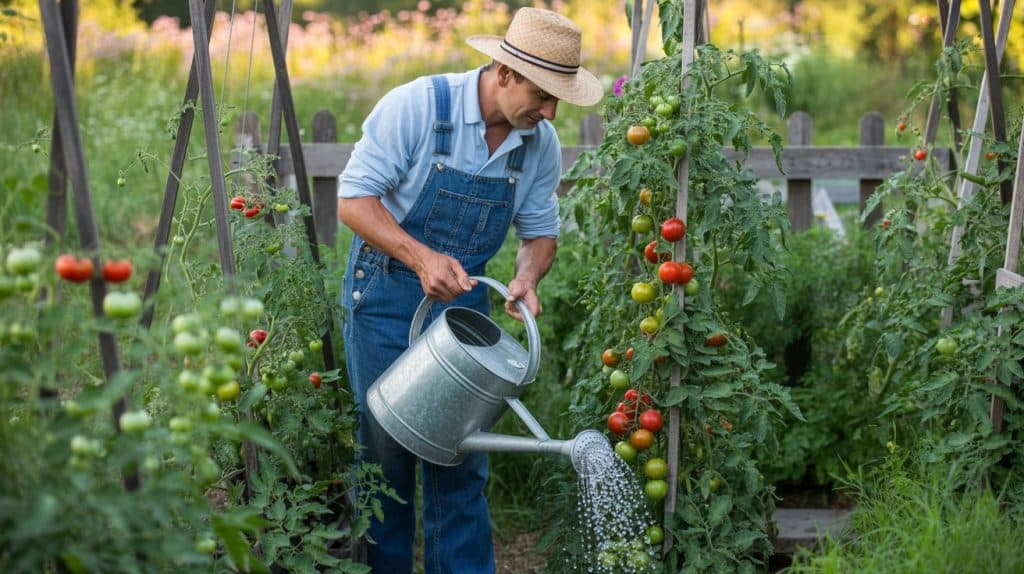
Proper care throughout the growing season ensures healthy plants and maximum fruit production from planting until harvest time ends.
- Watering Schedule: Water deeply once or twice weekly rather than daily light sprinkles to encourage deep root growth.
- Mulching Application: Apply 2 to 3 inches of mulch around plants to retain moisture and prevent weeds from competing.
- Fertilizing Routine: Fertilize every 3 to 4 weeks with balanced fertilizer, switching to low nitrogen during the fruiting stage.
- Pruning Practice: Prune suckers that grow between the main stem and branches to focus energy on fruit production.
- Plant Support: Use plant supports like stakes or cages to keep branches upright, then trim any soil-touching leaves to reduce moisture contact and maintain healthy airflow around foliage.
Protecting Tomatoes from Pests and Diseases
Prevention and early detection help keep tomato plants healthy by stopping problems before they cause serious damage to your harvest.
- Inspect plants weekly for signs of pests like hornworms, aphids, or whiteflies on leaves and stems.
- Remove affected leaves immediately when you spot disease symptoms like spots, yellowing, or wilting patterns.
- Rotate tomato location each year to prevent soil-borne diseases from building up in the same area.
- Use companion plants like basil, marigolds, or nasturtiums to naturally repel harmful insects from tomato plants.
- Apply organic fungicide spray during humid weather to prevent common diseases like blight or powdery mildew.
- Install row covers or netting to protect young plants from cutworms and other soil-dwelling pests.
When and How to Harvest Tomatoes?
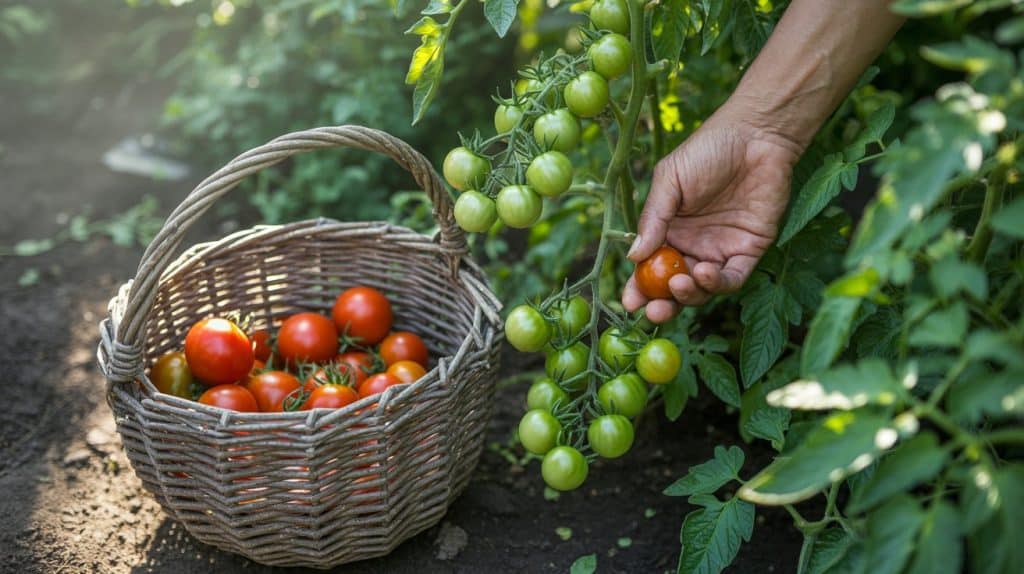
Timing your tomato harvest correctly makes the difference between bland, mealy fruit and perfectly ripe, flavorful tomatoes. Understanding ripeness stages helps you pick at the optimal moment for your intended use.
Remember that tomatoes continue to ripen after picking, so you don’t need to wait for them to turn full red on the vine. Indoor ripening often produces better texture and flavor than vine-ripened fruit in hot weather conditions.
Harvest Timing: Pick tomatoes when they show the first blush of color for best indoor ripening results. Morning harvest provides maximum moisture content and better storage life.
Proper Technique: Use clean scissors or twist gently to avoid damaging stems and branches. Check plants every 2-3 days during peak growing season.
Storage Methods: Store ripe tomatoes at room temperature for optimal flavor and texture. Refrigerate only fully ripe fruit for extended storage periods.
Green Tomato Ripening: Place green tomatoes in paper bags with apples or bananas for natural ethylene gas exposure. This speeds up the ripening process indoors.
Seed Saving Process: To save seeds from your best-tasting varieties, scoop out the gel and ferment for 3 days. Clean thoroughly and dry completely before storage.
End of Season Care: Continue watering and fertilizing plants after harvest to encourage more fruit production until first frost arrives. Remove healthy plant material for composting.
Final Thoughts
Growing tomatoes successfully requires patience, planning, and consistent care throughout the season.
From selecting the right variety for your space to harvesting at peak ripeness, each step builds toward a bountiful harvest.
Remember that tomato growing is a learning process where each season teaches valuable lessons about timing, care techniques, and problem prevention.
Start small with 2-3 plants your first year to gain experience without feeling overwhelmed.
Focus on providing consistent water, proper support, and regular monitoring for the best results.
Most importantly, enjoy the process and celebrate small victories along the way. There’s nothing quite like the taste of a homegrown tomato.
What questions do you have about growing tomatoes? Share your thoughts or experiences in the comments below!
Check out more posts on plant care and growing tips.
Frequently Asked Questions
Why Put Baking Soda Around Tomato Plants?
Baking soda reduces soil acidity, making tomatoes taste sweeter rather than tart. This simple trick improves fruit flavor naturally.
What Does Epsom Salt Do to Tomatoes?
Epsom salt provides magnesium that prevents yellow leaves and poor fruit production. It helps plants absorb nutrients and stay healthy.
What Is the Best Fertilizer for Tomatoes?
Cottonseed meal and aged chicken manure work well for young plants. These organic options provide nitrogen that tomatoes need naturally.
